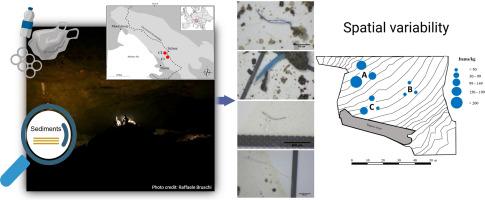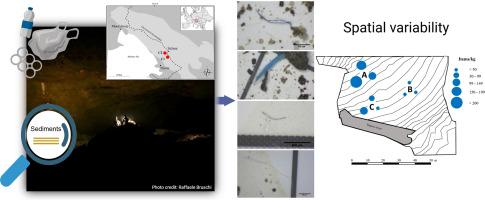Quantifying anthropogenic microparticle contamination in cave sediments: spatial heterogeneity matters
IF 7.3
2区 环境科学与生态学
Q1 ENVIRONMENTAL SCIENCES
引用次数: 0
Abstract
Anthropogenic microparticle pollution is a pervasive phenomenon affecting even remote environments, such as natural caves. Despite potential impacts on these fragile and valuable underground ecosystems, data on microparticle concentration in natural caves still remain sparse and often based on limited sampling and insufficient spatial replication. In this study, a hierarchical sampling design including large (between caves, 1000 s m), medium (subareas within caves, 10 s m), local (stations within subareas, 100 s cm) and small (among replicates, 10 s cm) scale, was implemented to identify patterns of spatial variation in microparticle contamination of surface sediments from two caves in the Classical Karst (NE Italy). Suspected anthropogenic microparticles were detected in all samples, with an average concentration of 90.9 items kg−1 dry weight, predominantly transparent particles (>34.9 %), often fibers <1 mm (49.9 − 58.1 %). Most of the items (94.5 %) were microplastics made of PP (45 %), PET (35 %), and PE (20 %), whereas the remaining microparticles consisted of non-plastic items, including unknown cellulose (5 %) and anthropogenic cellulose (0.5 %). The total number of microparticles, their type, and relative abundance significantly varied at the scale of subareas, while no significant variations were detected at the scale of stations and between caves. In all cases, subareas and replicates primarily contributed to the total variability (11 − 20 % and ≥80 %, respectively), highlighting small- and medium-scale heterogeneity as the most relevant sources of spatial variations of microparticle contamination. As a number of factors, from varying contamination sources to the geomorphological complexity of caves, may affect dispersal and accumulation of microparticles in environmental matrices, our findings stress the need for more structured sampling designs to quantify the intrinsic spatial variability of microparticles in order to obtain reliable estimates of contamination in cave environments.


洞穴沉积物中人为微粒污染的量化:空间异质性问题
人为微粒污染是一种普遍存在的现象,甚至影响到偏远的环境,如天然洞穴。尽管对这些脆弱而宝贵的地下生态系统有潜在的影响,但关于天然洞穴中微粒浓度的数据仍然很少,而且往往是基于有限的采样和不足的空间复制。本研究采用分层采样设计,包括大尺度(洞间1000米)、中尺度(洞内10米)、局部尺度(洞内100米)和小尺度(重复10米),对意大利东北部经典喀斯特地区两个洞穴表层沉积物微粒污染的空间变化规律进行了研究。在所有样品中都检测到疑似人为微粒,平均浓度为90.9项kg-1干重,主要是透明颗粒(34.9%),通常是纤维(49.9 - 58.1%)。大多数物品(94.5%)是由PP (45%), PET(35%)和PE(20%)制成的微塑料,而其余的微粒由非塑料物品组成,包括未知纤维素(5%)和人为纤维素(0.5%)。微粒子总数、类型和相对丰度在分区尺度上存在显著差异,而在站点尺度和洞穴尺度上无显著差异。在所有情况下,分区和重复对总变异性的贡献最大(分别为11% - 20%和≥80%),突出了中小尺度异质性是微粒污染空间变异的最相关来源。由于多种因素,从不同的污染源到洞穴地貌的复杂性,都可能影响微颗粒在环境基质中的扩散和积累,我们的研究结果强调需要更结构化的采样设计来量化微颗粒的内在空间变异性,以便获得可靠的洞穴环境污染估计。
本文章由计算机程序翻译,如有差异,请以英文原文为准。
求助全文
约1分钟内获得全文
求助全文
来源期刊

Environmental Pollution
环境科学-环境科学
CiteScore
16.00
自引率
6.70%
发文量
2082
审稿时长
2.9 months
期刊介绍:
Environmental Pollution is an international peer-reviewed journal that publishes high-quality research papers and review articles covering all aspects of environmental pollution and its impacts on ecosystems and human health.
Subject areas include, but are not limited to:
• Sources and occurrences of pollutants that are clearly defined and measured in environmental compartments, food and food-related items, and human bodies;
• Interlinks between contaminant exposure and biological, ecological, and human health effects, including those of climate change;
• Contaminants of emerging concerns (including but not limited to antibiotic resistant microorganisms or genes, microplastics/nanoplastics, electronic wastes, light, and noise) and/or their biological, ecological, or human health effects;
• Laboratory and field studies on the remediation/mitigation of environmental pollution via new techniques and with clear links to biological, ecological, or human health effects;
• Modeling of pollution processes, patterns, or trends that is of clear environmental and/or human health interest;
• New techniques that measure and examine environmental occurrences, transport, behavior, and effects of pollutants within the environment or the laboratory, provided that they can be clearly used to address problems within regional or global environmental compartments.
 求助内容:
求助内容: 应助结果提醒方式:
应助结果提醒方式:


